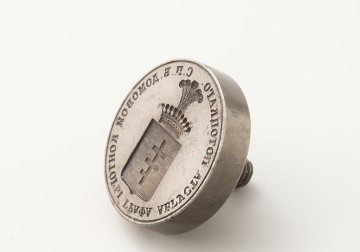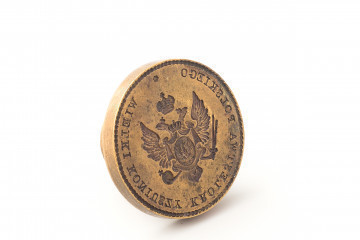
Seal matrix of the Church Administration of the Wilanów Parish
Museum of King Jan III's Palace at Wilanów
Part of the collection: Varia
In the collections of the Museum of King Jan III’s Palace at Wilanów, almost forty sphragistics pieces – seals or seal matrixes – have survived. The term ‘sphragistics’ is derived from the Greek word ‘sphragis’ standing for a seal (alternatively called sigillography after the Latin word ‘sigillum’) and defines the branch of auxiliary historical sciences where research focuses on interpreting the meaning of seals and determining the circumstances of their creation. The history of sphragistics dates back to the 19th century; at that time, it was noticed that seals could serve as a valuable source material contributing knowledge on political, heraldic and diplomacy arrangements as well as other motifs concerning the past.
The set of seals and seal matrixes preserved in the collection of the Museum dates back to the 18th century. Seals and matrixes are connected not only with the Wilanów estate. The set contains objects that can be associated with specific persons – the owners of Wilanów in the context of posts held by them, but also objects that document the system of administering estates and their functioning, not only the Wilanów estate.
The object shown here is an ink seal matrix (other matrixes can be used for lacquer seals). Its part containing the image to be impressed, in the shape of a lightly flattened oval, is concavely engraved (i.e., the impressed image is cut into the surface). The matrix has a preserved handle made of wood, with a concave-convex profile, covered with black lacquer on the surface. In the seal field, there are two French modern escutcheons shown against the background of a paludamentum topped with a count’s crown. The escutcheons depict emblems of the Pilawa coat of arms – two and a half of a cross – and Szreniawa without a Cross in the form of the reversed letter S, which symbolises the course of the Szreniawa river. Over the escutcheon with Pilawa there is a nine-stick count’s crown, and over Szreniawa there is a ducal mitre. The combination of these two coats of arms allows us to associate this seal matrix with the period in the history of Wilanów when representatives of both families lived there. Such a situation took place from the late 18th century, when Aleksandra née Lubomirska (1758 or 1760–1831) and her spouse Stanisław Kostka Potocki (1755–1821) became owners of the estate.
Author / creator
Dimensions
entire object: height: 9,0 cm, width: 3,8 cm
Technique
carving,rolling
Material
brass,wood
Owner
Museum of King Jan III's Palace at Wilanów
Identification number
Location / status

Museum of King Jan III's Palace at Wilanów

Museum of King Jan III's Palace at Wilanów

Museum of King Jan III's Palace at Wilanów
DISCOVER this TOPIC
Castle Museum in Łańcut
DISCOVER this PATH
Educational path